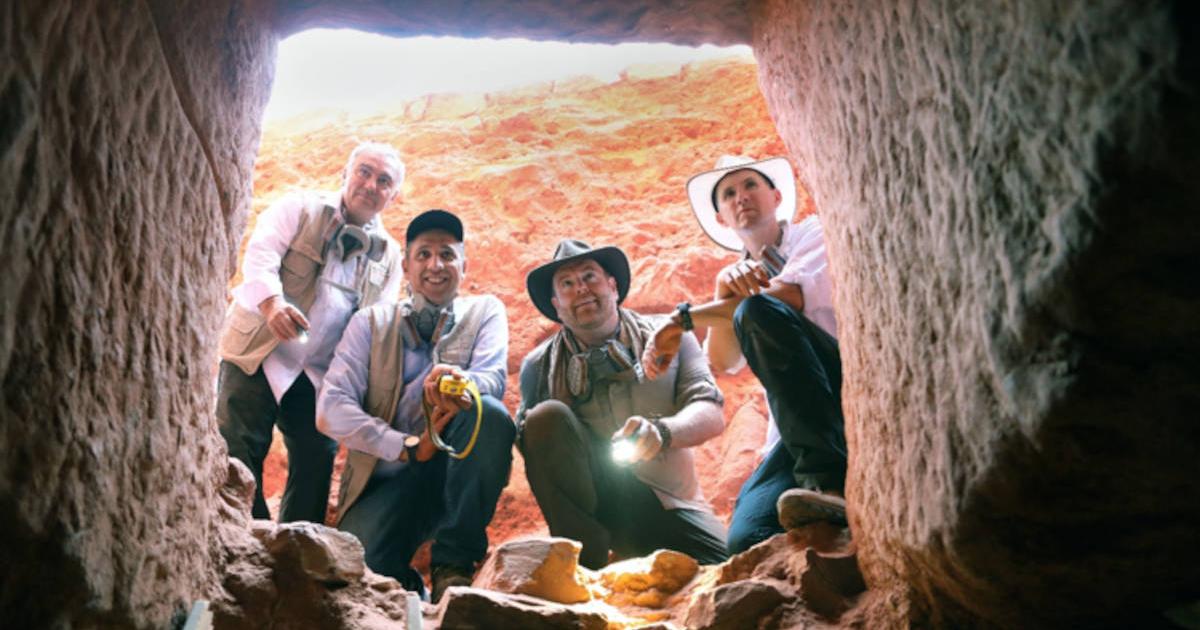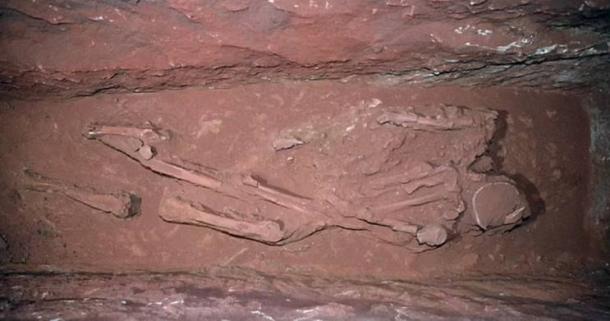
Tomb Discovered Beneath Petra Holds Human Remains and ‘Holy Grail’ Cup
A hidden tomb containing the remains of at least 12 individuals and an artifact resembling the 'Holy Grail' has been discovered under Petra’s famous Al Khazneh, one of the Middle East's greatest monuments and an iconic filming location for the 1989 film Indiana Jones and the Last Crusade.
Unlike other tombs previously unearthed in Petra, which were largely empty, this tomb contained well-preserved skeletal remains and artifacts that are believed to be over 2,000 years old, reports The Times of Israel. The discovery sheds new light on the lives of the Nabataeans, a sophisticated civilization that once flourished in this region of southern Jordan.
The recent excavation, led by Dr. Pearce Paul Creasman, executive director of the American Center of Research (ACOR), in collaboration with Josh Gates from the Discovery Channel’s Expedition Unknown, marks a rare archaeological discovery beneath the famed ‘Treasury’ of Petra. Although Petra has been explored for over two centuries, this new tomb, containing 12 well-preserved skeletons and a grail-shaped ceramic chalice, proves there are still unknown treasures at the site.
- The Qasr al-Farid, the Lonely Castle of the Nabataeans
- Were the Women of Petra More Important Than the Men?

Josh Gates and the team at the excavation site in Petra. (© Discovery’s Expedition Unknown)
Petra’s Hidden History: The Search for Underground Tombs
Al Khazneh, or “The Treasury,” is one of Petra’s most famous and enigmatic structures. Carved into the sandstone cliffs of southern Jordan around the 1st century AD, it served as a mausoleum and crypt, likely for King Aretas IV of the Nabataean Empire. While its magnificent exterior has been studied extensively, the interior and subterranean chambers have long intrigued archaeologists.
Back in 2003, explorers found two tombs containing partial skeletal remains below the left side of Al Khazneh, the Daily Mail explains. However, ground-penetrating radar suggested the presence of additional chambers on the right side of the structure. Armed with this knowledge, Dr. Creasman’s team sought permission from the Jordanian government to explore further, eventually leading to the remarkable August 2024 excavation.
The Grail Mystery: Fact Imitating Fiction
When the team finally excavated The Treasury, they uncovered a previously unknown tomb filled with human remains, artifacts of bronze, iron, and ceramic, and, coincidentally, a chalice, reportedly bearing an uncanny resemblance to the fabled ‘Holy Grail’ featured in Indiana Jones and the Last Crusade.
“This is a hugely rare discovery,” said Josh Gates, host of the Discovery Channel’s Expedition Unknown, who was on-site to document the dig, quotes The Times of Israel article.
“In the two centuries that Petra has been investigated by archaeologists, nothing like this has been found before.”
- The Truth About the Holy Grail: Magical Chalices Around the World
- The Chalice of Magdalene – Is this the Holy Grail?

Ceramic chalice object found in the tomb. (© Discovery’s Expedition Unknown)
The similarity between the two grails—one a product of cinematic imagination and the other a 2,000-year-old artifact—has captivated experts and enthusiasts alike.
Josh Gates noted the almost surreal coincidence of art imitating life. “It really was this awesome moment of history imitating art,” Gates told CNN.
“This may be the largest discovery of human remains within a single site in Petra,” Gates remarked. The presence of at least 12 skeletons suggests that the tomb could have served as a burial place for prominent individuals, potentially members of the Nabataean elite.

The lost tomb at Petra was found to contain 12 well-preserved human skeletons. (© Discovery’s Expedition Unknown)
Ancient Lives Revealed: Who Were the Buried?
The remains are believed to be over 2,000 years old. According to Dr. Creasman, the remains found within the tomb, represent a significant discovery.
“The burials in this tomb are articulated, so the bones haven’t been rummaged around and moved, so that’s exceedingly rare,” Creasman explained, quotes the Daily Mail.
The Nabataeans were an ancient Arab people whose empire, at its peak spanned modern-day Jordan, Israel, Egypt, Syria, and Saudi Arabia. Petra, their capital, flourished as a major trading hub due to its strategic location along the Incense Route, connecting the Arabian Peninsula with the Mediterranean. Petra is thought to have been home to over 20,000 people, making it a major urban center in an otherwise desolate region.
Although the Nabataean kingdom eventually came under Roman control in AD 106, Petra remained an important city until its gradual decline. The people buried in this newly discovered tomb may have lived during this transitional period, and further analysis of their remains could reveal much about their lives, such as their professions, health, diets, and the age at which they died.
Petra’s Enduring Mysteries and Future Discoveries
The newly discovered tombs provide a rare glimpse into the lives of the Nabataean people and the burial practices of Petra, which continues to yield fascinating discoveries. Despite centuries of archaeological exploration, Petra’s vast complex of tombs, temples, and homes still holds secrets. The fact that significant finds can still be made in such a prominent location highlights just how much remains to be uncovered at this ancient site.
Dr. Creasman believes that this latest find is just the beginning. “Even in front of one of the most famous buildings in the world, there are still huge discoveries to be made,” he said.
The team is particularly interested in examining the condition of the skeletons, which could reveal information about the health, diet, and social status of the individuals buried in the tomb. While it is not yet clear who these individuals were, their proximity to the Treasury suggests that they were of considerable importance.
Top image: Josh Gates and the team at the entrance of the tomb found at Petra. Source: © Discovery’s Expedition Unknown
By Gary Manners
References
‘Josh Gates Explores Historic Finds at Petra.’ Press release. Warner Bros. Discovery. Available at: https://press.wbd.com/us/media-release/first-look-josh-gates-explores-historic-finds-petra-one-new-seven-wonders-world-new?language_content_entity=en















Comments
Not coincidence, just rational thinking in the “Last Crusade”. A strange thing though, the very narrow base of the chalice. May be it had to be inserted in a wider disc shape base, that for practical reasons was not created as one piece with the chalice.